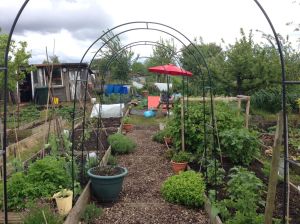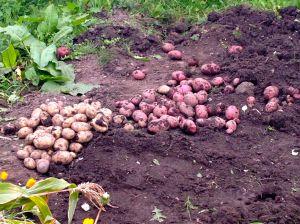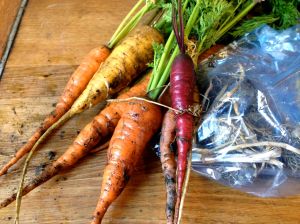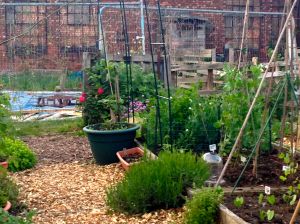You may have watched the Big Allotment Challenge on the BBC and seen the pristine plots that the gardeners started with. (Don’t get me started on that programme… ) Sadly, it is very rarely the case that the previous plot holder will have left the plot in this condition, so the first thing you will have to do will be to clear the ground and create order. Some plots are better than others – some will be full of rubbish. Others will need weeding and maybe soil improvement.
The good news is that a fallow (unplanted) period will restore soil fertility after any heavy cropping. Weeds, believe it or not, are a good sign.
Tall weeds are best cleared using a scythe or a machete. You can then dig over the ground. This can be hard and heavy work, so try not to tackle one large piece of ground at once. Dig small areas, and either cover them with light excluding, water permeable fabrics or plant them up straight away (it is shocking how quickly weeds will reclaim your freshly dug earth, and covering or planting will check the growth of weeds and preserve your hard work). Don’t use light coloured or clear fabric – you’ll create a little weed hot-house.
My advice is to plant as many things as you can (time of year dependent) as soon as possible, so that you can enjoy the fruits of your labour (literally) and feel like your efforts are paying off.
Managing your plot
Once your plot is cleared, it will need constant attention to keep it productive and in good order. Some people say that it can be done in 30 minutes a day, I’m not so sure. You’d have to have superhuman watering and weeding powers to achieve that. I suppose if you just see it as a food growing exercise it can be done. I like to arrive, chat on the way in to whoever is about, get to the plot, survey my domain, think about what needs doing.
The kinds of jobs on a typical visit (assuming that you don’t have ongoing big projects as we do) are weeding, sowing and planting, harvesting (this takes much longer than you might imagine especially in the summer months – like a LOT longer), managing your waste, feeding and watering, pruning, manuring, cleaning and clearing. Did I mention managing waste… that’s a biggy. There’ll be tree prunings, brambles, weeds, grass clippings, random rubbish… so many different things to recycle, or to process… There’s a lot to do. Which is great because you get to be in the outdoors being productive and useful and growing great food.
Each year numerous people take on a new plot full of vim and gusto, but quickly lose interest. Of course, you won’t know if you have an aptitude for growing your own, or the interest to sustain you through the hard slog, until you have given it a go. Don’t feel bad if an allotment isn’t for you, but be sure to let your site secretary know so that it can be re-le before it gets overgrown – in the summer months that happens remarkably quickly.
Soil Structure and Fertility
Even within the same plot soil quality will vary. On our plot we garden on heavy clay soil. Clay offers a nutrient rich and moisture retentive environment for plants, but its molecules can be very dense and difficult for plant roots to penetrate. It can also mean that your soil gets very cold in winter and is slow to warm up in spring, and may become waterlogged. Few plots will have been completely unimproved, but it will probably be the case that the structure of the soil will have been “opened up” by the incorporation of compost and manure, and sometimes grit or sand. However, regular manuring or composting will maintain the nutrients in the soil, will improve growing conditions and provide better drainage. A 3-5 cm per year top dressing should be enough. Spread it on your beds, and the worms will do the rest of the work for you.
What to grow?
One of the fun things about growing your own vegetables is choosing varieties that you will never (or very rarely) find in the shops, and eating them within hours of picking so that they retain their natural sugars and flavours. There are so many possibilities for growing weird and wonderful food, as well as everyday staples. Whatever you read in books (some of which discourage the growing of potatoes and onions because they are cheap and readily available) almost everything you grow will be tastier than its shop-bought counterpart. This is partly because shop varieties are often grown for their uniform growing habits and storage capabilities, and partly because of the time that passes between harvest and the food getting to your table. Choose to grow the vegetables you enjoy eating, but maybe try to grow a few new things every season – you might find a new favourite.
Easy Wins
Some things are easier to grow than others. They will crop with minimal effort and a less prone to disease or bird attack. Why not try the following:
Swiss Chard – a slightly mineral-tasting green leaf with sweet thick ribbed stems. Leaves can be used as spinach. Stems should be cooked for slightly longer, but may be used as a separate vegetable. This is an absolute favourite of mine. The stems are sweet and soft, and the leaves have a slight mineral flavour and are silky soft.
Kale – Kales are packed full of vitamins and anti-oxidants. They come in a vast array of shapes and colours, so are not only good for eating, they also make your plot look pretty. I’m all for using veg in an ornamental way by varying the shapes and colours of what I grow.
Beans – runner beans and French beans are excellent croppers, and are particularly suited to our soil type and conditions. Try dwarfing varieties for the lowest maintenance, or grow climbing varieties on frames or pyramids.
Courgettes (that’s zucchini to the non-brits)– the courgette is the classic glut plant (that means that you’ll get loads). They come in all sorts of weird and wonderful colours, shapes and sizes – not just the long green ones you buy in the shops. Freshly picked they are firm and nutty tasting.
Salad leaves – prepare your self for a taste sensation. Salad leaves come in so many flavours from the peppery to the watery, the bitter to the mild. They can be grown throughout most of the year (if protected under plastic, glass or fleece in winter), and they are a doddle.
Staples
Staples are worth growing particularly if you are an organic grower.
Potatoes – are one of the most sprayed vegetables, so growing your own means that you get a much cleaner product. First and second early potatoes grow quite quickly (between March-May and June-July). They come out of the ground sweet and earthy. They should be eaten quite quickly. Main crop potatoes are more prone to blight later in the season and are in the ground for longer (until September). These can be stored and used throughout the winter months. We live in Manchester where the climate is very humid, so blight is a problem most years. The trick to avoid spoiled tubers is to cut down the haulms to a couple of inches and burn any excess.
Onions & Garlic – also one of the most heavily chemically sprayed commercial crops, onions can be dried for use throughout the winter, and handled carefully will have a better flavor than most of what can be bought in the shops. I’ve never had a full crop of big, round, plump onions. So far I’ve only managed to grow a motley crew of different shapes and sizes. But they have tasted good.
Carrots – clay soil is not ideal for carrots, although the addition of horticultural sand will make growing conditions more favourable. They also grow well in deep containers. Be warned that they have to be sewed in situ, because moving them releases their scent into the air, alerting the pesky carrot-fly to their whereabouts. Which leads to maggoty carrots. But teeny fresh carrots in a salad are a revelation. And you can grow ones in a veritable rainbow of colours, which is rather fun.
A bit of luxury
Some vegetables are expensive to buy, or hard to find in the shops. The following is a list of the vegetables that we think will add a touch of luxury to your table.
Shallots – these sweet little onions have a milder, subtler flavour than bigger onions. They are also a piece of cake to grow.
Sweetcorn – it’s true that these are readily available in the supermarket, but the sugars in sweetcorn starts turning to starch as soon as it’s picked. That means that it is at its very best barbecued straight from the plant on your plot, or at most cooked in the way you enjoy within an hour or so of picking. This is a definite favourite on our site.
Florence fennel – fennel has a sweet, aniseed flavour, and tastes great braised, grilled, baked, or eaten raw.
Oriental greens – pak choi, mizuna, tatsoi, bok choi – these are excellent late season greens that are unusual outside China Town, but are very easy to grow, and are lovely to eat as a side vegetable, or used in soups and stir fries.
Herbs
Is there anything better than a lovely aromatic herb bed? Nope! Herbs add flavour and interest to all kinds of dishes. On the plot they can either be grown in a dedicated bed, or dotted around amongst other plants. And the bees love ‘em.
So, if you are just starting off with a new plot, or are thinking about putting your name down for an allotment, I hope that this post is of some use. If I’ve missed out anything that you’d like to know about, let me know in the comments, and I’ll see what I can do.






Leave a comment